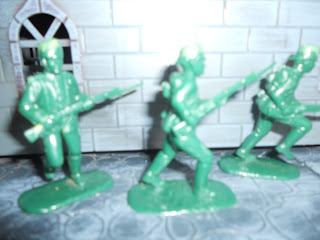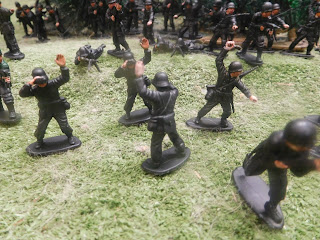Lead On The Work Bench
Below: 14 hollowcast figures are now undercoated with an enamel white undercoat spray. (It is worth doing a test spray first as some undercoats have a granulated finish. This one didn't).
The bases are cut from cardboard ring binder folders. I have put aside my plan to base all my hollowcast and others on laser cut bases. The laser cut wooden bases ranged from 50 to 80 cents. That might not sound like much but when I am basing thousands of figures it adds up. In fact, some of my figures are cheaper than such bases! The figures were glued to bases with a hot glue gun. I had to be careful to not get strands of glue festooning the bases and even the figure s I picked those off before undercoating, especially as I might decide not to flock these bases. I painted the bases using a sample acrylic pot from Bunnings.
My favorite yachtsman is at front. He has a drummer's arm which looks the same as the original. The drum was cut down to pipe size and some putty added to suggest a pipe cup.
The first two Indians are nice figures although American Indians with tomahawks are next to useless in a wargame, unless they are attacking from ambush. It reminds me of the Indiana Jones scene where the martial arts expert does a lot of waving his lethal limbs and sword around before Jones just shoots him dead. I have a couple more of these Native Americans so I might replace tomahawks with bows. The bases are painted with a sample acrylic paint from Bunnings. The other Indian had such a rough face I trimmed the chin down a little.
This is what the figures look like after I dipped them in methylated spirits and scrubbed them with a toothbrush. I then rinsed them in turpentine and put them outside in the sunshine to dry.
I read somewhere that sealing lead figures with enamel varnish protects them from corrosion (lead rot). The only figures I had lead rot problems with were some home lead castings that were probably entirely lead and possibly kept in a damp environment, but I want to be sure. I should have used mat varnish but a satin Humbrol one the was at hand, so I used it.
I
A spare arm was added to the highlander at left. The two hiughlanders are differnt heights and the next one does nt have the campaign equipment. The next figure is a surgeon general. (I think that's the term).
The Hilco mounted cowboy did not come with my latest aquisitions. All legs and right arm have been made from copper wire and Green Stuff. I'll be sanding and trimming these further and then might add some liquid GS to smotth things over. Some wire is left protruding on legs to anchor into the base.
The Australian light Horseman is a home casting I already had.
This Indian lacked a head and his body was cracked open at the shoulders. I filled it up with hot glue and inserted the head. I also added Super Glue around the head. The head is a casting of a Britains plastic swoppet Indian (or a HK coy of). I trimmed off, from the back, the cascading remains of the feather bonnet. Green Stuff finished off the filling.
Tiny Britains nurse
This headless figure was given a peaked cap head which was a home casting copy of plastic Britains zookeeper.
The figures below were part of my recent purchase of figures for $50. There are a total of at least 64 figures. I didn't pay postage as I picked them up from the seller's doorstep. (Travel also cost me nothing as I had a lift and a free train ticket home).
The headless figure, at left, is a stretcher bearer. I am debating with myself whether to complete him with a home service helmet or a tropical one. The stout headless figure is unknown to me so any information is appreciated. I am guessing he is a civilian figure. The piper has only minor and easily filled damage.
The figures I didn't show in my initial photo...




























Wow!
ReplyDeleteThese turned out nice!!
I think your first pictures showed them in such a poor condition that they couldn't be salvaged.
Mind you, these are some of the best ones. The most damaged of the 'restored' ones was the kneeling American Indian.
ReplyDelete